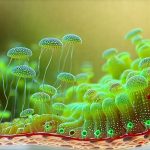The human body is often perceived as a singular entity, but in reality, it’s an incredibly complex ecosystem teeming with trillions of microorganisms – bacteria, viruses, fungi, and archaea. This vast community, collectively known as the microbiome, plays a pivotal role in nearly every aspect of our health, from digestion and immunity to mental wellbeing. While we often focus on bacterial balance within the gut, the fungal component is equally significant, and imbalances can lead to uncomfortable and even debilitating conditions. A healthy microbiome isn’t simply about having microbes; it’s about maintaining a diverse and harmonious relationship between them, ensuring no single population dominates to the detriment of others.
The delicate equilibrium of this microbial world can be disrupted by numerous factors – diet, stress, antibiotic use, environmental toxins, and even lifestyle choices. When the bacterial populations decline due to these stressors, it creates an ecological niche that allows fungal organisms, particularly Candida species, to proliferate unchecked. This overgrowth isn’t necessarily a sign of infection in the traditional sense; rather, it’s a symptom of a larger systemic imbalance within the microbiome and the body’s overall health. Understanding how gut health influences fungal growth is crucial for developing effective strategies to restore balance and support long-term wellbeing.
The Gut Microbiome & Fungal Overgrowth: A Delicate Dance
The gut microbiome acts as a first line of defense against opportunistic pathogens, including fungi like Candida. A robust bacterial population competitively inhibits fungal growth through several mechanisms. – They compete for the same nutrients, limiting what’s available to fungi. – They produce antimicrobial substances that directly inhibit fungal proliferation. – They strengthen the gut barrier, preventing fungal translocation (movement) into the bloodstream and other tissues.
When the microbiome is compromised – often referred to as dysbiosis – this natural defense system weakens. Antibiotics, while life-saving in many situations, are notorious for indiscriminately killing both beneficial bacteria and potentially harmful ones, leaving space for fungi to flourish. Similarly, a diet high in refined sugars and processed foods feeds fungal growth while simultaneously suppressing the populations of beneficial bacteria that would normally keep them in check. This creates a vicious cycle where fungal overgrowth further disrupts the microbiome, leading to more imbalance and potential health problems.
The interplay isn’t simply one of direct competition; it’s also about metabolic byproducts. Beneficial bacteria ferment dietary fiber into short-chain fatty acids (SCFAs) like butyrate, which have numerous beneficial effects on gut health, including strengthening the gut barrier and modulating immune function. Fungi, however, produce different metabolites that can contribute to inflammation and further disrupt microbiome balance. Maintaining a diverse and thriving bacterial population is therefore essential for preventing fungal overgrowth. Understanding gut transit time can also help manage this process.
Factors Contributing to Gut Yeast Imbalance
Several factors beyond antibiotics and diet can significantly impact the gut’s microbial composition and increase susceptibility to fungal imbalance. Chronic stress, for instance, releases cortisol, which can suppress immune function and alter gut motility, creating an environment more favorable to fungal growth. Similarly, conditions like diabetes or impaired glucose metabolism provide a readily available food source for fungi.
- Leaky Gut: A compromised intestinal barrier (“leaky gut”) allows undigested food particles, toxins, and even fungal elements to enter the bloodstream, triggering inflammation and further disrupting microbiome balance. This creates a feedback loop where increased permeability leads to more imbalance, which in turn exacerbates permeability.
- Immune Dysfunction: A weakened immune system is less able to effectively control fungal populations within the gut. Conditions like autoimmune diseases or chronic infections can compromise immune function, making individuals more susceptible to overgrowth.
- Environmental Toxins: Exposure to mycotoxins (toxins produced by molds) and other environmental pollutants can further burden the immune system and disrupt microbiome balance, contributing to yeast imbalance.
Addressing these underlying factors is crucial for long-term restoration of gut health. It’s not enough to simply eradicate fungi; you must address the root causes that allowed them to proliferate in the first place. This often involves a multifaceted approach encompassing dietary changes, stress management techniques, and potentially immune support strategies. A focus on rebuilding a diverse and resilient microbiome is paramount. The vagus nerve also plays a key role in these processes.
Dietary Strategies for Microbiome Support & Fungal Management
Diet plays an incredibly important role in both preventing and addressing gut yeast imbalance. A cornerstone of any strategy should be reducing sugar intake – not just refined sugars but also excessive amounts of natural sweeteners like honey or maple syrup. Fungi thrive on sugar, so minimizing its availability is critical. Simultaneously, increasing fiber intake provides nourishment for beneficial bacteria, helping to restore balance.
- Prioritize whole, unprocessed foods: Focus on vegetables, fruits (in moderation), lean proteins, and healthy fats.
- Incorporate prebiotic foods: Prebiotics are non-digestible fibers that feed beneficial bacteria in the gut. Examples include garlic, onions, leeks, asparagus, and bananas.
- Consider fermented foods: Fermented foods like sauerkraut, kimchi, yogurt (unsweetened), and kefir contain live probiotics (beneficial bacteria) that can help repopulate the gut. However, individuals with significant fungal overgrowth may need to introduce these gradually as they can sometimes exacerbate symptoms initially.
It’s also worth noting that certain foods can be particularly problematic for individuals with fungal sensitivities. These might include molds and yeasts found in aged cheeses, fermented beverages (like beer or wine), and even some mushrooms. Identifying and eliminating individual food triggers is an important part of the process. A food elimination diet, guided by a healthcare professional, can be helpful in identifying these sensitivities. Understanding GERD and its connection to microbiome health is also relevant here.
Beyond Diet: Lifestyle Factors & Gut Health
While dietary changes are foundational, lifestyle factors also play a significant role in shaping the microbiome and influencing fungal balance. Managing stress through techniques like meditation, yoga, or deep breathing exercises can help reduce cortisol levels and support immune function. Regular physical activity promotes gut motility and enhances microbial diversity. Adequate sleep is essential for both immune function and overall health.
- Minimize antibiotic use: Use antibiotics only when absolutely necessary and under the guidance of a healthcare professional. If antibiotic use is unavoidable, consider supplementing with probiotics afterward to help restore the microbiome.
- Reduce exposure to environmental toxins: Minimize exposure to molds, mycotoxins, pesticides, and other environmental pollutants as much as possible.
- Support gut barrier integrity: Consider incorporating supplements like L-glutamine or zinc carnosine, which can help strengthen the intestinal lining.
A holistic approach that addresses all these factors is essential for long-term gut health and preventing fungal overgrowth. It’s not about quick fixes; it’s about cultivating a lifestyle that supports a thriving microbiome and a resilient body. Remember to consult with a qualified healthcare professional before making any significant changes to your diet or supplement regimen, particularly if you have underlying health conditions. Further research into IBS can also be beneficial for those experiencing gut imbalances. Finally, consider how your microbiome influences motion sickness.


















